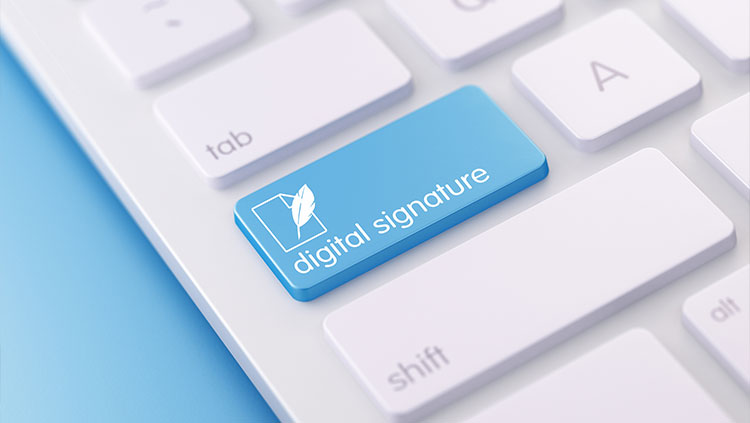Loading component...
6 tips for using electronic signatures
Content Summary
- Technology
- Public practice
Loading component...

This article was current at the time of publication.
While there are still some situations where only a “wet ink” signature will do, COVID-19 restrictions have opened a window for electronic signatures to become more accepted and forced the law to adapt and embrace the evolving business landscape.
Like many technological innovations that are now widespread, platforms facilitating the use of electronic signatures have become a vital tool to conduct business.
Some larger organisations understood their potential early and have been using them for years, but it wasn’t until COVID-19 hit that the benefits have been more broadly embraced.
What the law says about e-signatures
In Australia, Electronic Transaction Acts (for the Commonwealth and each state and territory) permit e-signatures, which have the same legal status as handwritten signatures – with the proviso both parties agree to their use.
As a result of COVID, temporary amendments to a number of state, territory, and Commonwealth laws were made to remove these exclusions because of restrictions on movement and physical contact.
“The result is a myriad of different laws and navigating how they apply is best undertaken with caution,” says Kimberley Martin, who has written extensively on the subject and is Director at Worrall Moss Martin Lawyers (WMM) in Hobart.
Federal government legislation covers the corporate sphere, where many temporary provisions have now expired, most notably those in the Corporations Act on 21 March 2021.
Although a Bill to make them permanent was adjourned until early August, the government has since succeeded in getting parliament to extend temporary amendments to the Corporations Act to provide greater certainty around e-signing by companies.
Security measures
Antoine Pace, a partner at Gadens in Melbourne, says security has improved with the ongoing development of easy-to-use platforms designed for electronic signatures.
“The use of e-signatures has been around for a while, but for various reasons including the fact that there was uncertainty about their acceptance in court due to the patchwork of state-based laws and cross-border issues, in many cases, users or potential users – including lawyers – were slow to pick up the utility of electronic signatures.”
COVID-19 has certainly changed that, he adds.
“There are now electronic signature platforms in place that are easy to use and that will provide an audit trail of transaction data to help provide assurance to users that the person whose signature is on a document is likely to be the person who ‘signed’ the document.”
This, he explains, includes data evidencing the time and date of signature and the IP address and approximate location of the computer used to affix the signature.
"But don't throw your pens away just yet, because the electronic regime relies on a number of factors being met. One of these is a willingness by all parties to use electronic signatures. Where one of the parties does not agree – that’s fatal."
Rick Shera, partner at Lowndes Jordan, also notes that there is an important difference between electronic and digital signatures and that it may become a security issue.
“From a practical perspective we’re seeing a lot more interference with email systems,” he reveals.
“I think that presents a danger for electronic signatures exchanged by email, which has been the traditional way we've done it.”
The security aspect – or potential lack of security in the case of emails – is something we all need to start thinking about in terms of whether it should be an acceptable way of exchanging signed documents, Shera says.
6 tips for accounting practices
WMM’s Kimberley Martin says there are some basic steps to take when considering using e-signatures.
- Determine when e-signatures can be used and if unsure, seek legal advice.
- Develop an e-signature policy, procedural and practice guide – outline the circumstances in which it is acceptable to use e-signatures with clients and how clients will be identified remotely.
- Determine which e-signature software and videoconferencing software to use. Consider the user experience by ensuring that the person who is least technically able within your practice can satisfactorily use the software.
- Check software security. Is there a dedicated compliance team and how does the software meet requirements in each jurisdiction?
- If you’re working from home, be sure to maintain client privacy. If there are other people at home, use a headset and find a private space to conduct calls and videoconferences.
- Develop a safe custody policy for document storage. Do you print them out? Are you going to save them to a specific drive? What is your process and policy about where things must be stored for future access? How is it backed up and where?
Loading component...
Discover more
Cyber security breach shines spotlight on data protection
Recent data breaches show up weaknesses in New Zealand businesses’ privacy protection
- Public practice
- Technology
- Data management
article·Published onSign on the dotted line: how digital identification systems work
Signing on the dotted line: how digital identification systems really work
- Technology
- Public practice
article·Published onDo you have the right advisory tools?
You may already have the software you need to build your advisory business
- Technology
- Public practice
article·Published on6 tips for using electronic signatures
Legal experts weigh in on witnessing documents using e-signatures. Here’s what you need to know.
- Technology
- Public practice
article·Published onProfessional indemnity insurance claims: cyber risk
11 December 2020 | Join our experts as they share real-life claims
- Public practice
- Technology
Published on39 min read timeSecurity settings
Multi-Factor Authentication (MFA) will be introduced between November 2025 and February 2026. When required, you will be prompted to set up MFA for your online account. It will only take a few minutes and will help keep your account secure.
- Technology
